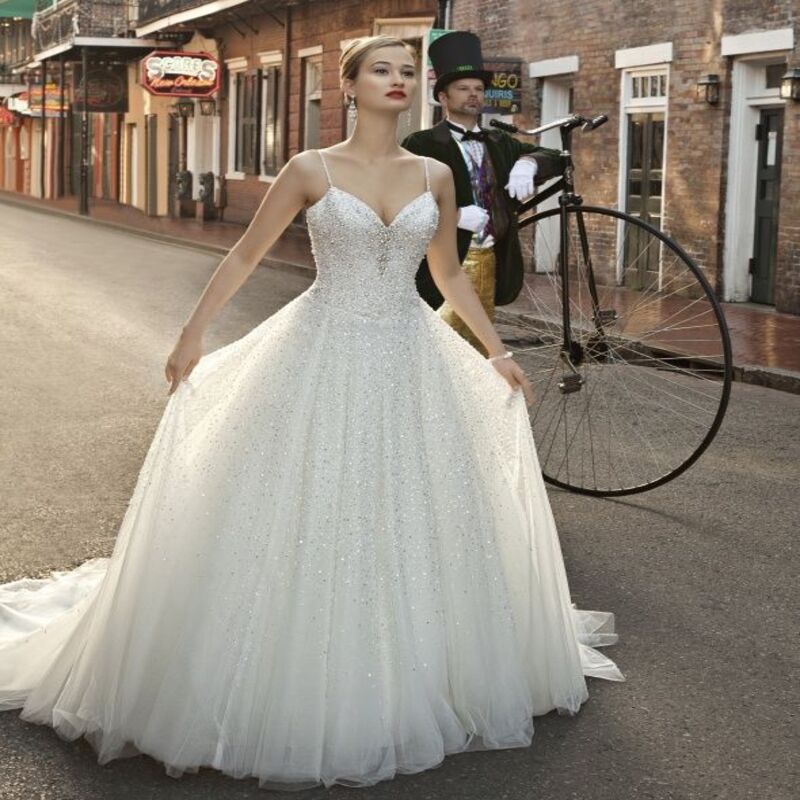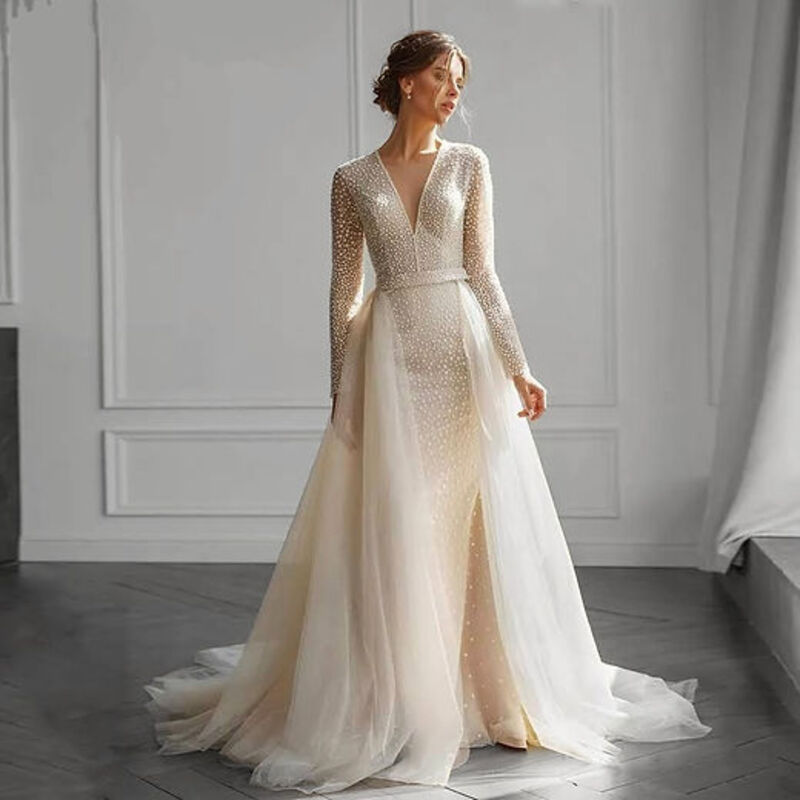Introduction to Wedding Dress Alterations
On your wedding day, your dress should fit flawlessly. The key is wedding dress alterations. These adjustments ensure your gown fits your body perfectly. Getting the fit right is critical. It’s not just size – it’s about elegance and comfort. Alterations can enhance the dress’s original beauty. They tailor the gown to your unique shape and style.
Alterations involve changes like hemming the length or adjusting the bust. Other common changes include tightening or loosening areas, such as the waist or hips. You may also want to add details. These could be lace, beads, or a personal touch.
Keep in mind, how long the alterations take depends on their complexity. More detailed work will require more time. Expect to start the alteration process a few months before the wedding.
Remember, this is an essential step in your wedding preparations. It transforms a beautiful gown into one that feels like it was made just for you. So, start early, find a skilled tailor, and communicate clearly. This will ensure your gown is perfect for your special day.

Key Considerations Before Starting Alterations
Before you dive into the alteration process, several key factors must be taken into account. Here are the most crucial considerations to ensure a successful and stress-free alteration experience for your wedding dress:
- Start Early: Timing is vital. Begin thinking about alterations at least six months ahead. This allows for a relaxed timeline.
- Know Your Dress: Understand the structure and style of your dress. Certain fabrics and designs may demand more complex alterations.
- Set a Budget: Be clear on how much you’re willing to spend. Alterations can vary in cost, so have a budget in mind from the start.
- Find the Right Tailor: Not all tailors are experienced with bridal gowns. Look for someone who specializes in wedding dress alterations.
- Schedule Appointments: Book your initial fitting at least three months before the wedding. Arrange subsequent fittings closer to the date.
- Expect Weight Fluctuations: Your weight may change. Choose a tailor who can accommodate last-minute tweaks if necessary.
- Bring Your Accessories: Have your shoes and undergarments ready for each fitting. They impact how your dress fits.
- Communication is Key: Be clear about what you want. If you have ideas or concerns, discuss them with your tailor.
- Consider the Location: Think about where you will get married. Different venues may require specific alterations, like a bustle for dancing.
By keeping these factors in mind, you’ll be better prepared to navigate the alterations process and achieve the perfect fit for your wedding gown. Remember, successful alterations are all about planning, understanding your needs, and clear communication.
Ideal Timeline for Wedding Dress Alterations
When planning wedding dress alterations, timing is everything. Here’s an ideal timeline to ensure a perfect fit for your big day:
- At Least 6 Months Before: Start shopping for your dress. Allow time for delivery and any pre-alteration repairs.
- 3 Months Before: Schedule your first fitting. This allows for a clear vision of adjustments needed before the wedding.
- 6 to 8 Weeks Before: Have a second fitting. The closer to your wedding, the more accurate the fit.
- 2 to 3 Weeks Before: Final fitting time. Any small tweaks will be done to ensure a flawless look.
- 1 Week Before: Pick up your dress. Make sure all alterations are completed and you’re satisfied with the fit.
- Day Before or of Wedding: Last glance to confirm no last-minute fixes are needed. If your weight stayed steady, there should be no surprises.
This timeline assumes you’ll see a skilled tailor known for their timely work. Remember, certain dresses or changes may require more time. Give yourself a cushion to handle unexpected delays. By following this timeline, you’ll be on track for a wedding dress that looks and feels like a dream.

Types of Common Wedding Dress Alterations
Every bridal gown is unique. Yet, many need similar tweaks to fit perfectly. Understanding common alterations helps you anticipate changes and discuss them with your tailor. Here’s what many brides require:
- Hemming: Gowns often need length adjustments. This ensures you won’t trip on your big day.
- Reshaping the Neckline: Sweetheart, straight, or plunge, the neckline might need reworking for the best look.
- Size Adjustments: Dresses are taken in or let out to hug your figure just right.
- Adding or Removing Sleeves: Sleeve alterations cater to your preference and the ceremony’s formality.
- Adding a Bustle: A bustle lets you move freely post-ceremony by lifting the train.
- Bra Cup Insertion: For better shape and support, cups can be sewn into the gown.
- Shortening Straps: To prevent slippage, straps may need adjusting for a secure fit.
- Customizing Back Closure: Change from zippers to corsets or buttons for style or better fit.
- Adding Embellishments: Personalize with beads or lace to make your dress truly yours.
- Train Adjustments: Shortening or shaping the train can be both functional and stylish.
Each alteration makes your dress more yours. It’s a crucial step to achieving the bridal look you’ve dreamed about.
Selecting the Right Tailor for Your Alterations
When it comes to wedding dress alterations, choosing the right tailor is crucial. Your tailor’s skill will directly impact the final fit and look of your gown. Hence, taking time to select a professional with the right experience is essential. Here’s how to pick the best tailor for your wedding dress alterations:
- Start the Search Early: Don’t wait until the last minute. Begin searching for tailors at least six months before your wedding. This will give you enough time to review their work and book appointments.
- Look for Specialization: Choose a tailor who specializes in wedding gowns. They understand complex fabrics and delicate designs that others may not.
- Check Reviews: Read online reviews or ask for recommendations from friends or family. Previous brides can offer insights into a tailor’s quality of work and customer service.
- Compare Services: Talk to several tailors to understand their services and prices. This helps you find the best match for your needs and budget.
- Ask Questions: When meeting with a tailor, ask about their experience with gowns similar to yours. Inquire about the turnaround time and their approach to complex alterations.
- Consider Location: Pick a tailor who is conveniently located. Close proximity eases the process of attending multiple fittings.
Remember, a good tailor listens and advises. Communicate your vision clearly and be sure they understand your alteration needs. Their expertise will transform your dress into the perfect fit for your special day.
Preparing for Your Alteration Appointments
Preparing for your alteration appointments is a critical step in ensuring your wedding dress fits perfectly. Here’s a simple guide to make sure you’re ready for each visit to the tailor.
- Book Early: Schedule your fittings as soon as possible. Aim for your first fitting around three months before your wedding.
- Bring Essentials: Always take your wedding shoes and the undergarments you’ll wear on your big day to every fitting.
- Know What You Want: Have a clear idea of the alterations you need. Think about the dress’s length, the neckline, and the overall fit.
- Speak Clearly: Describe what you want in simple terms. Be direct about the fit and any style changes.
- Take Notes: Write down important details or questions you have for the tailor. Don’t forget to bring them to your appointment.
- Stay Consistent: Keep your weight stable to avoid last-minute alterations. Frequent changes can affect the dress’s fit.
- Ask for Timeframes: Find out how long each alteration will take. This helps plan for future fittings.
- Check the Work: Look over alterations at each fitting. Ensure the changes meet your expectations.
By following these steps, you’ll ensure a smooth alteration process. Remember, the goal is to make your wedding dress fit as if it was custom-made for you.

Understanding the Costs of Wedding Dress Alterations
Understanding the costs involved with wedding dress alterations is crucial for budgeting for your big day. Here are key points to consider when estimating the expense of tailoring your gown:
- Get a Rough Estimate Early: Seek quotes from tailors as you begin your dress search. This helps you set a realistic alterations budget.
- The Complexity of Alterations: Simple adjustments like hemming cost less than complex changes like resizing. The more intricate your gown’s design, the higher the alteration cost may be.
- Tailor’s Experience: Experienced tailors may charge more but ensure high-quality work. Their expertise can be worth the extra cost.
- Additional Alterations: Adding a bustle or bra cups might incur separate charges. Factor in these potential costs.
- Final Touches: Budget for any last-minute adjustments that may be needed as your wedding day approaches.
- Ask About Packages: Some tailors offer alteration packages that might save money compared to individual charges.
To avoid surprises, discuss all potential alterations and their costs at your first fitting. Keep in mind that prices can vary widely. In Singapore, for instance, brides can spend between $150 and $700 on average, depending on the work required. Customizing a dress can push costs up to $1,200 or more. Always confirm prices and what they include before proceeding.
In sum, while costs can be high, remember that perfect alterations are an investment in looking and feeling great on your wedding day.
Final Tips for a Perfect Fit on Your Big Day
As your wedding day draws near, ensure your dress alterations are perfect. Here are some final tips:
- Check Fit and Comfort: Try on your dress after final alterations. It should fit snugly and allow ease of movement.
- Inspect Details: Look over the dress carefully. Check seams, hems, and any added details like lace or beading.
- Second Opinion: Have a friend or family member view the dress. They may notice things you missed.
- Practice Walking: Move around in your dress. Practice walking, sitting, and dancing to test comfort.
- Plan for Emergencies: Have a small sewing kit ready. It’s handy for any unexpected issues on your big day.
- Stay Hydrated: Drink plenty of water. It helps maintain your weight and the dress’s fit.
- Dress Rehearsal: Wear your entire outfit before the wedding. Combine the dress, shoes, and accessories to see the complete look.
- Relax and Trust: You’ve planned well. Trust your tailor’s work and relax. It will show in your confidence and smile.
Remember, the goal is to look and feel your best. With the right preparations, your wedding dress will be as ready for your big day as you are.
